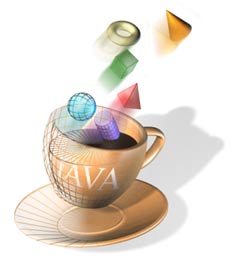
|
|

FB 4
Internationale Media and Computing
MeSoII: Media Software II
Sommersemester 2003
|
Exercise 6: Getting
Started with the Java 3D API
So now we are going to start learning how programs such as 3D StudioMax and Photoshop produce their results. We won't quite get a complete 3D StudioMax working, but we will be doing our best!
The exercise for this week is not a jGuru one. It
is a large .pdf file, more like a book and not really suited for reading on screen.
Oh well. It's a book by Dennis J Bouvier published by Sun Microsystems. The link
ist http://java.sun.com/products/java-media/3D/collateral/.
You can find the API, the tutorial, and the source code for all the example programs
at this address. The author suggests three modules for working with the tutorial.
We will spend one exercise on each module; however, we won't cover everything
in the book.
- Chapter 0 has some information on using this tutorial,
including a discussion of all the example programs, a glossary, and solutions
to selected exercises. Start reading Chapter 1, explaining how a virtual world
is constructed. This should sound a lot like what you learned about VRML in MMK
in the 4th semester. Copy and compile the program HelloJava3Da.java. Note that
you have to include a good many imports statements for this to compile! Can you
figure out why the cube is red?
- Chapter 1.7 tells you about rotating the
cube. Think waaaaay back to Mathematics to remember what degrees of rotation are
and that funny number PI. Copy and compile HelloJava3Db.java, making a slight
rotation on your cube. What would be the difference if you reversed the order
of the multiplication in the specification of the rotation? Alter the program
to see if your answer is correct. There are only two lines of code to change here!
- Just breeze through 1.8 and read 1.9. Try HelloJava3Dc.java and see if
you can get your cube to spin!
- HelloJava3Dd.java puts it all together.
What would be the difference if you reverse the order of the TransformNodes above
the ColorCube in the content branch graph? Alter the program to see if your answer
is correct.
- Chapter 2 goes deeper into using geometry to create worlds.
This is only for the bored! The rest of us skip to
Chapter 3 and skip over to 3.4. Here we meet our old friend, 2D Text, but now
in a 3D context. Copy out Text2DApp.java, compile and run it. Do you have the
font on your system? If all else fails, use Ariel! And now for the crowning touch:
can you get Text3DApp.java to run? Make some cool text and include a snapshot
in your report.
- (only for the bored) Playing
with the BackgroundApp.java example program, if you move far enough away from
the origin of the virtual world, the background disappears. Why does this happen?
If you add another Background object to the BackgroundApp, what will the effect
be?
The URL to your report, which will describe what you did during the exercise
and include links to your code, is due in email box of your instructor by 8.00 next Wednesday. Do not forget to put your names on the top of the report! It is also a good idea put the number of the exercise somewhere in the title of your report.... When you
send the URL of the report to your instructor, always include your partner in the CC. That way we don't get either
2 emails or none, because each or your thought the other was sending it. This has the added advantage that when we answer
you, we can immediately answer both of you without having to look up the
email account of your partner.
Copyright 2003,
Debora Weber-Wulff
(weberwu@fhtw-berlin.de)

